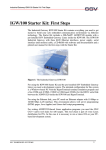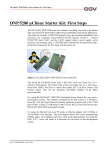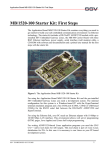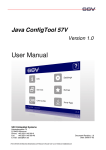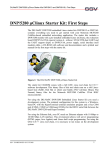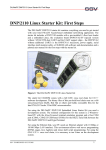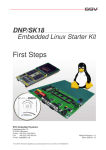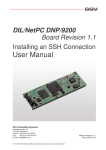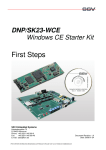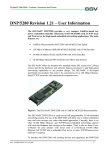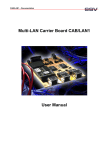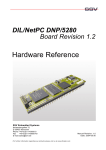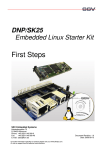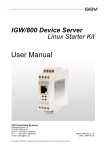Download ADNP/ESC1 µClinux Starter Kit: First Steps
Transcript
DIL/NetPC ADNP/ESC1 µClinux Starter Kit: First Steps ADNP/ESC1 µClinux Starter Kit: First Steps The DIL/NetPC ADNP/ESC1 starter kit contains everything you need to get started with your Altera NIOS-based embedded networking application. The starter kit includes a ADNP/ESC1 module with a pre-installed embedded Linux (uClinux), the evaluation board DNP/EVA7, power supply, serial interface (null modem) cable, a CD-ROM with software and documentation and a printed user manual for the first steps with the starter kit. Figure 1: The DIL/NetPC ADNP/ESC1 µClinux Starter Kit The starter kit CD-ROM comes with a full GNU cross tool chain for C/C++ software development. This binary files of this tool chain runs on a x86 Linuxbased host (SuSE, Red Hat or other) and builds bFLT (uClinux Binary Flat Format) binary files for the Altera NIOS 32-bit soft core microcontroller. For using the DIL/NetPC ADNP/ESC1 Embedded Linux Starter Kit you need a development system. The minimal configuration for this system is a Windowsbased PC with the HyperTerminal terminal emulation program and a free COM port (COM1, COM2 or USB-based COMx) for the RS232 serial link between the DIL/NetPC ADNP/ESC1 and HyperTerminal. For using the Ethernet link, your PC needs an Ethernet adapter with 10 Mbps or 10/100 Mbps LAN interface. This environment allows web server programming (HTML pages, Java Applets) and Linux shell script programming. For using the GNU C/C++ cross tool chain, it is necessary to run Linux on the development system. SSV EMBEDDED SYSTEMS 1 DIL/NetPC ADNP/ESC1 µClinux Starter Kit: First Steps The ADNP/ESC1 Embedded Linux Starter Kit Key Features The DIL/NetPC ADNP/ESC1 pre-installed embedded Linux consists of two main components: 1. the Linux kernel and 2. the root file system. The ADNP/ESC1 Flash also offers a Flash Loader for downloading new versions of the Linux kernel and the root file system. This in-system programming feature can be used by a simple serial and Ethernet link between the development system and the ADNP/ESC1. • DIL/NETPC ADNP/ESC1 with 50 MHz Altera NIOS RISC Softcore, 16 Mbytes SDRAM, 8 Mbytes Flash and 10/100 Mbps Ethernet • Firmware and Embedded Linux pre-installed in Flash memory • Evaluation Board DNP/EVA7 with a pre-installed CompactFlash card • Null modem Cable • 110 VAC or 230 VAC to 5 VDC International Power Supply • CD-ROM with User Manual and Hardware/Programmers Manuals • Embedded Linux with Source • GNU Cross Tool Chain for C/C++ Software Development for Linux-based PCs • elf2flt Converter Program (NIOS ELF to uClinux bFLT) • NIOS ELF GNU gdb for RS232-based Remote Debugging • Linux Remote Login with Telnet • Web Server Setup Sample • Embedded FTP Server for Ethernet-based up- and downloads • Many Sourcecode Samples SSV EMBEDDED SYSTEMS 2 DIL/NetPC ADNP/ESC1 µClinux Starter Kit: First Steps 1. Step: Cable for the Serial Link between the ADNP/ESC1 and a PC Set-up the serial link between the DIL/NetPC ADNP/ESC1 Evaluation Board and your PC. Use a Null modem cable for this connection. Figure 2: Serial Link between the DIL/NetPC Evaluation Board and the PC Connect one end of the Null modem cable with a unused COM port of your PC. Make sure, that this PC COM port supports 115.200 bps. SSV EMBEDDED SYSTEMS 3 DIL/NetPC ADNP/ESC1 µClinux Starter Kit: First Steps 2. Step: Cable for the Ethernet Link between the ADNP/ESC1 and a PC Set-up the Ethernet LAN link between the DIL/NetPC ADNP/ESC1 Evaluation Board and your PC. Use an Ethernet Cross-over cable for the first LAN connection. Figure 3: Ethernet Link between the DIL/NetPC Evaluation Board and the PC Please note: The ADNP/ESC1 comes with a pre-installed DHCP client program. This client runs at boot time and try out to get a IP address from a DHCP server. Please make sure that the ADNP/ESC1 can find a DHCP server within your LAN and that this server supply’s valid IP addresses for new LAN members. SSV EMBEDDED SYSTEMS 4 DIL/NetPC ADNP/ESC1 µClinux Starter Kit: First Steps 3. Step: Connect the Power Supply and Power-up the Starter Kit Connect a 5 VDC power supply to DIL/NetPC Evaluation Board. Make sure, that the + voltage is within the center of power supply connector. Figure 4: Power Supply for the DIL/NetPC Evaluation Board Please note: Make sure, that all cable connections a OK. Then power-up the starter kit. SSV EMBEDDED SYSTEMS 5 DIL/NetPC ADNP/ESC1 µClinux Starter Kit: First Steps 4. Step: Using the Serial Link with a Terminal Program Run HyperTerminal on your Windows-PC, minicom or a similar simple terminal emulation program on your Linux-based PC. Figure 5: Direct Connection Set-up with HyperTerminal Set-up a direct connection with the parameters of Table 1. Make sure, that the PC COM port supports 115.200 bps. Figure 6: Parameter Set-up with HyperTerminal Parameter Speed Data Bits Parity Stop Bits Protocol Value 115.200 bps 8 Keine 1 No (Xon/Xoff, RTS/CTS or similar) Table 1: Set-up Parameters for the Serial Link SSV EMBEDDED SYSTEMS 6 DIL/NetPC ADNP/ESC1 µClinux Starter Kit: First Steps 5. Step: Power-up the ADNP/ESC1 without RCM Jumper Without the RCM jumper, the DIL/NetPC ADNP/ESC1 is booting µClinux from Flash memory within some seconds. The first messages comes from the U-BOOT boot loader. Figure 7a: Watch the U-BOOT boot loader with HyperTerminal The terminal emulation program offers a serial console to the ADNP/ESC1 µClinux. You can enter and execute µClinux commands with the terminal emulation program after the boot process finish’s. Figure 7b: Watch the µClinux booting process with HyperTerminal SSV EMBEDDED SYSTEMS 7 DIL/NetPC ADNP/ESC1 µClinux Starter Kit: First Steps 6. Step: Power-up the ADNP/ESC1 with RCM Jumper With the RCM jumper, the DIL/NetPC ADNP/ESC1 runs the default flash loader program GERMS direct after power-up from a NIOS ROM memory space. Figure 8: Using GERMS with HyperTerminal The monitor program GERMS needs a special setup of your terminal program. It is necessary, that the terminal program adds a LF (Line Feed) direct after each CR (Carriage Return). HyperTerminal offers a special ASCII configuration for this mode. SSV EMBEDDED SYSTEMS 8 DIL/NetPC ADNP/ESC1 µClinux Starter Kit: First Steps 7. Step: Check the IP Address of your PC Make sure that your PC is using the right IP address for the Ethernet-based TCP/IP communication with the DIL/NetPC. Use 192.168.0.1 or 192.168.0.254 for your PC and 192.168.0.126 for the ADNP/ESC1. Figure 9a: Check the ADNP/ESC1 IP address with ifconfig Talk to your network administrator if you have problems with the IP address understanding. Figure 9b: Windows-PC IP address check with ipconfig SSV EMBEDDED SYSTEMS 9 DIL/NetPC ADNP/ESC1 µClinux Starter Kit: First Steps 8. Step: Check the Ethernet-based TCP/IP Communication Check the Ethernet-based TCP/IP communication between the ADNP/ESC1 and the PC with a simple ping command. Figure 10: Windows-PC TCP/IP communication check with ping First check the cable connections and then the IP addresses if your ping doesn’t work. SSV EMBEDDED SYSTEMS 10 DIL/NetPC ADNP/ESC1 µClinux Starter Kit: First Steps 9. Step: Check the ADNP/ESC1 Embedded Web server Run a Web browser program. Enter the URL http://192.168.0.126 for access the ADNP/ESC1 Web pages. Figure 11: Check the Embedded Webserver with Internet Explorer Please note: The ADNP/ESC1 default HTML pages and GIF pictures are located at /home/httpd of your DNP/EVA7 CompactFlash memory card. SSV EMBEDDED SYSTEMS 11 DIL/NetPC ADNP/ESC1 µClinux Starter Kit: First Steps 10. Step: Using a Telnet Connection Run a Telnet client program on your PC with the IP address of the ADNP/ESC1. You can use a Telnet session for remote entering µClinux commands. Figure 12: Run the Windows Telnet client program Please note: The DIL/NetPC ADNP/ESC1 µClinux comes with a simple shell. All ADNP/ESC1 µClinux command lines commands are implemented in this simple shell. The utilities in simple shell generally have fewer options than their full-featured GNU cousins; however, the options that are included provide the expected functionality and behave very much like their GNU counterparts. The simple shell provides a fairly complete environment for any small or embedded system. A ADNP/ESC1 Telnet session needs a login. Please use the user name root and the password uClinux (please use the same small and capital letters). Figure 13: Using µClinux commands within a Telnet client window SSV EMBEDDED SYSTEMS 12 DIL/NetPC ADNP/ESC1 µClinux Starter Kit: First Steps The DIL/NetPC ADNP/ESC1 µClinux is mounting the CompactFlash memory card of your DNP/EVA7 to the directory /home. The directory /home/httpd of the memory card offers the content for the ADNP/ESC1 embedded Web server. Please enter the following HTML lines with the help of your ADNP/ESC1 Telnet session: cd /home/httpd cat > test.html <html> <head> <title>Hello World!</title> </head> <body> <h1> Hello World!</h1> </body> </html> CTRL-D (Stops the Linux cat command) The DIL/NetPC ADNP/ESC1 µClinux stores your HTML lines in the file /home/httpd/test.html of your DNP/EVA7 CompactFlash memory card. Then run a Web browser program. Enter the URL http://192.168.0.126/test.html Change the IP address within this URL if necessary. The Web browser shows the HTML output for test.html. Figure 14: Output of /home/httpd/test.html SSV EMBEDDED SYSTEMS 13 DIL/NetPC ADNP/ESC1 µClinux Starter Kit: First Steps Helpful Literature DNP/EVA7 Hardware Reference Manual DIL/NetPC ADNP/ESC1 Hardware Reference Manual Contact SSV Embedded Systems Heisterbergallee 72 D-30453 Hannover Tel. +49-(0)511-40000-0 Fax. +49-(0)511-40000-40 E-Mail: [email protected] Web: www.ssv-embedded.de Web: www.dilnetpc.com Notes to this Document (DNPSK15-FirstStepsE.Doc) Revision Date 1.00 14.07.2004 Name First Version in English (Rev. 1.00) KDW © SSV Software Systems GmbH and Klaus-Dieter Walter 1999 – 2004. All rights reserved. No part of this documentation may be copied or reproduced in any form or by any means without the prior written consent of SSV Software Systems GmbH and Klaus-Dieter Walter. Trademarks, brands, or names included in this documentation are for identification purposes only and may be the property of others. SSV Software Systems GmbH makes no warranty for the use of its products and assumes no responsibility for any errors which may appear in this documents nor does it make a commitment to update the information contained herein. SSV Software Systems GmbH retains the right to make changes to these specifications at any time, without notice. Contact the SSV Software Systems GmbH sales office to obtain the latest specifications before placing your order. SSV EMBEDDED SYSTEMS 14














